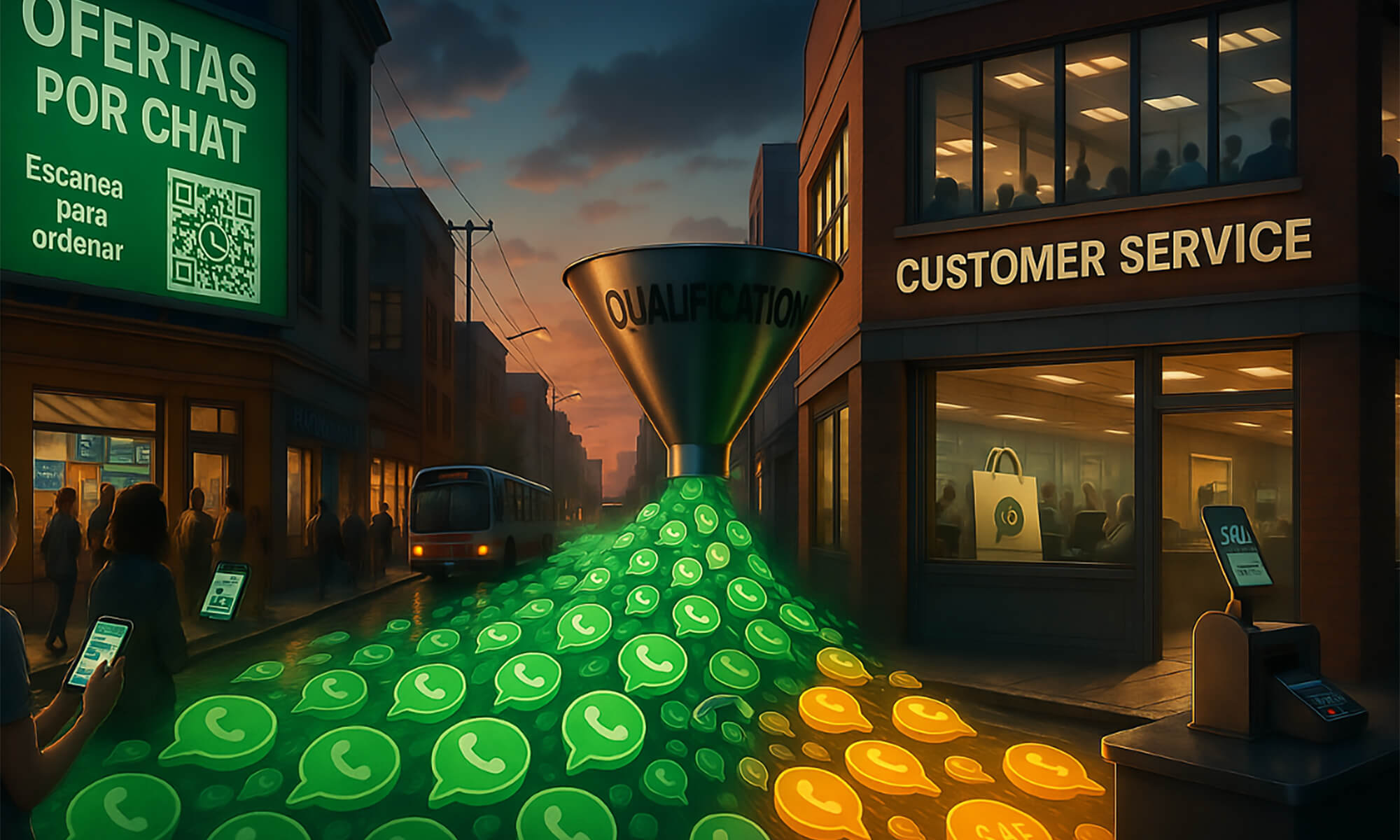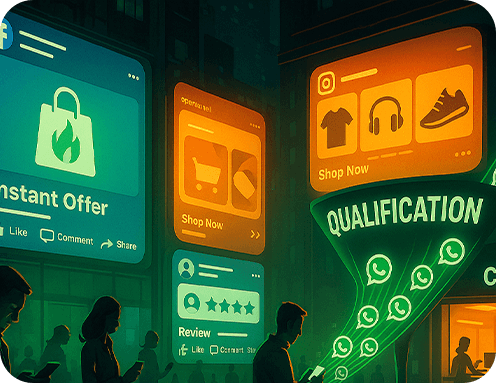WhatsApp Traffic Without Sales Is Just Expensive Customer Service
In the past year I have written more than enough about how consumers in Latin America are flocking to Whatsapp to buy their products and services. Still, this is no guarantee that they are going to buy from YOU.
Getting a shiny new multichannel platform with an AI bot and all the bells and whistles is no guarantee that your sales are going to grow. You first need to get discovered, that is, you need to drive quality traffic towards your Whatsapp.
Driving traffic means generating quality incoming conversations from different sources. Yes, I know, you are already getting a ton of chats. You can barely keep up. But how many of those chats are customer service requests? Unqualified leads who are just messing around? Time wasting people just messing around?
If growing sales on Whatsapp is your goal read on. I think I might have a tip or two to help you do just that!
Today I am going to teach you about everything that needs to happen to drive qualified leads to your Conversational Commerce channels.
We will discuss:
• Target audience and value proposition definition
• Social Network advertising
• Traditional media advertising
• Printed offline QR Codes
Target audience and value proposition definition
The foundation of any successful WhatsApp traffic generation strategy starts with laser-focused audience segmentation and a compelling value proposition. Recent studies show that 75% of Latin American consumers prefer to interact with companies through messaging platforms like WhatsApp, but this preference alone doesn’t guarantee sales. You need to identify who your ideal customers are and what specific problems they’re trying to solve.
Customer Segmentation Framework:
Start by mapping your customers into actionable segments based on their behavior, not just demographics. Successful conversational commerce allows companies to collect and analyze customer data in real-time, identifying behavioral patterns and preferences. For most businesses, this means understanding that your customers likely fall into distinct purchasing behaviors:
- Immediate buyers: Those ready to purchase within 24 hours.
- Research-driven shoppers: People who compare prices and need social proof.
- Relationship-first customers: Buyers who need to trust the brand before purchasing.
- Price-sensitive segments: Customers whose primary concern is cost.
Lead Qualification System:
Before driving traffic, establish clear qualification criteria. Not all WhatsApp conversations are created equal. Based on the sales funnel framework, implement a three-tier qualification system:
- Cold leads: Initial inquiries or general interest.
- Warm prospects: Engaged customers asking specific product questions.
- Hot leads: Ready-to-buy customers with clear purchase intent.
Value Proposition Testing:
Your WhatsApp value proposition should be different from your website or email marketing. WhatsApp offers direct communication channels where customers can quickly resolve queries or make purchases without leaving conversations. Test propositions like:
- “Get instant answers from real experts”.
- “Skip the website – buy directly through chat”.
- “Exclusive WhatsApp-only deals and early access”.
Market Context for Guatemala:
According to Guatemala’s e-commerce study 2025, social networks represent 48.8% of online sales channels, with an average 30.3% increase in online sales from 2023 to 2024. For retail, tourism, and e-commerce businesses, this represents a massive opportunity to capture qualified traffic through precise audience targeting.
Remember: the goal isn’t to get more chats – it’s to get more qualified chats that convert to sales.
Social Network advertising
Social media advertising remains the most scalable way to drive qualified traffic to your WhatsApp business account. Click-to-WhatsApp ads appear across Facebook and Instagram feeds, stories, and marketplace, enabling businesses to start direct conversations with potential customers. But success requires understanding the unique dynamics of Latin American social media behavior.
Click-to-WhatsApp Ad Strategy:
The secret to successful social media advertising for WhatsApp traffic is creating ads that feel native to the platform while providing clear value. Studies show that 50% more sales can be achieved through combined campaigns using click-to-WhatsApp ads alongside regular campaigns.
Ad Format Recommendations:
- Video ads showcasing products in action: 67% of mobile users in Mexico watch videos on mobile devices at least once per day.
- Carousel ads with multiple product options: Let customers choose what to chat about.
- User-generated content: 34% of American adults depend on customer reviews to learn about products.
Targeting Strategy for Latin America:
Focus your targeting on behavioral indicators rather than broad demographics. Target users who have:
- Engaged with similar businesses on WhatsApp.
- Made online purchases in the last 90 days.
- Shown interest in your specific product categories.
- Used mobile payment apps or services.
Ad Copy Best Practices:
Your ad copy should create urgency while highlighting the convenience of WhatsApp communication.
Examples that work:
- “Get instant pricing via WhatsApp – no forms required”.
- “Chat with our experts now for personalized recommendations”.
- “Exclusive WhatsApp deals – limited time only”.
Budget Allocation Framework:
A/B testing shows that combined campaigns with click-to-WhatsApp ads and regular ads reduce cost per transaction by 33%. Allocate 60% of your social media budget to click-to-WhatsApp campaigns and 40% to traditional conversion campaigns, then optimize based on your qualified lead metrics.
Platform-Specific Strategies:
- Facebook: Focus on detailed interest targeting and retargeting website visitors.
- Instagram: Use visual storytelling and influencer-style content.
- Meta Advantage+: Let Meta automatically optimize placements across Facebook, Instagram, and Messenger.
Lead Qualification Through Ads:
Use your ad copy to pre-qualify leads. Instead of generic “Contact us” messages, use specific calls-to-action like “Ready to place your order? Message us now” or “Need a custom quote? Chat with our specialists.”
Traditional media advertising
While digital channels dominate, traditional media still plays a crucial role in driving WhatsApp traffic, especially for businesses targeting older demographics or those building brand awareness across multiple touchpoints. Marketers are now using multi-channel implementation across email (47%), product packaging (46%), events (43%), print ads (40%), and in-store displays (40%).
Radio and TV Integration:
Traditional media works best when it creates urgency and provides a simple call-to-action. For Central American markets, radio remains highly effective for local businesses. Your traditional media should:
• Include memorable WhatsApp numbers (preferably with repeating digits)
• Offer time-sensitive promotions exclusive to WhatsApp inquiries
• Create urgency: “Call or message us on WhatsApp in the next hour for exclusive pricing”
Print Advertising Strategy:
Newspaper and magazine ads should function as bridges to digital engagement. QR codes in print ads boost conversions by 35% when they link to exclusive online offers. Include:
• Large, scannable QR codes that open WhatsApp chats
• Clear value propositions for contacting via WhatsApp
• Specific messaging for different publications and audiences
Out-of-Home (OOH) Advertising:
Billboards and transit advertising work exceptionally well for WhatsApp traffic generation because they catch people when they’re already on their phones. Best practices include:
• Large phone numbers that are easy to remember
• QR codes positioned at eye level for easy scanning
• Simple, action-oriented messaging: “Scan to order,” “Message for instant quotes”
Cross-Channel Coordination:
Traditional media should reinforce your digital messaging, not compete with it. Create consistent campaigns where:
• Radio mentions match your Facebook ad messaging
• Print ads use the same visual elements as your Instagram content
• TV commercials end with the same WhatsApp call-to-action used online
Measurement and Attribution:
Traditional media attribution for WhatsApp traffic requires creativity:
- Use unique promotional codes for each traditional channel.
- Ask new WhatsApp contacts where they heard about you.
- Track spike patterns in WhatsApp inquiries after traditional media campaigns.
- Use specific WhatsApp numbers for different traditional media campaigns.
ROI(Return On Investment) Optimization:
Traditional media ROI improves dramatically when it drives WhatsApp conversations rather than website visits. WhatsApp messages have 98% open rates compared to ~20% for email, making it a more reliable conversion path from traditional media exposure.
Integration with Digital Retargeting:
Use traditional media exposure to enhance your digital retargeting. People who see your billboard or hear your radio ad but don’t immediately respond can be retargeted with social media ads that remind them to start a WhatsApp conversation.
Printed online and offline QR Codes
QR codes represent the perfect bridge between offline discovery and WhatsApp engagement. WhatsApp QR codes account for 7% of all QR codes created globally, and their usage has grown significantly year-over-year. For businesses in retail, tourism, and e-commerce sectors, QR codes provide an immediate, friction-free way to convert offline interest into online conversations.
Strategic QR Code Placement:
Physical Locations:
- Point-of-sale: QR codes at customer service desks allow immediate access to support.
- Product packaging: Include QR codes for post-purchase support and reordering.
- Storefront windows: Capture after-hours interest with “Scan to shop 24/7” messaging.
Digital Placement Strategy:
- Email signatures: Every team member should include a WhatsApp QR code.
- Website headers: Prominent placement for immediate customer service access.
- Social media profiles: Direct social followers to WhatsApp for personalized service.
- Digital receipts and invoices: Enable easy reordering and support.
QR Code Optimization Best Practices:
Technical Requirements:
- Minimum 2cm x 2cm size for reliable scanning.
- High contrast (dark QR code on light background).
- Include your logo in the center without compromising scannability.
- Test scanning from various distances and lighting conditions.
User Experience Design:
Include clear calls-to-action like “Scan to Chat” and use pre-filled messages to save time.
Your QR codes should:
- Open with a pre-written message relevant to the context.
- Include your business name in the automatic message.
- Specify the type of help available (“Scan for product info,” “Scan for reservations”).
Pre-filled Message Examples:
- Retail: “Hi [Business Name], I’m interested in learning more about your products”
- Tourism: “Hello, I’d like information about your hotel availability and rates”
- E-commerce: “Hi, I saw your QR code and want to place an order”
Lead Qualification Through QR Codes:
Use different QR codes to automatically segment leads:
- Product-specific codes: Generate separate codes for different product lines.
- Location-based codes: Track which physical locations generate the most qualified leads.
- Campaign-specific codes: Measure ROI from different marketing initiatives.
Analytics and Optimization:
Only 31% of marketers monitor the post-scan journey, and just 16% tie QR codes directly to revenue. Implement comprehensive tracking:
- Monitor scan rates by location and time.
- Track conversion from scan to actual WhatsApp conversation.
- Measure conversation-to-sale conversion rates.
- Analyze which pre-filled messages generate the most qualified leads.
Advanced QR Code Strategies:
Dynamic QR Codes:
69% of marketers update QR code destinations at least monthly. Use dynamic QR codes that allow you to:
- Change the destination WhatsApp message based on campaigns.
- Update pre-filled text for seasonal promotions.
- Redirect codes to different WhatsApp numbers based on capacity.
Integration with AI Automation:
Pair QR codes with AI chatbots for immediate response:
- Automatic qualification questions upon scan.
- Instant product recommendations based on scan location.
- Immediate connection to human agents for high-intent scans.
Market-Specific Considerations for Guatemala:
According to Guatemala’s business statistics, 70.7% of e-commerce businesses have 0–5 e-commerce employees, making QR codes essential for automating customer acquisition without increasing staff requirements. QR codes enable small businesses to capture leads 24/7 while maintaining personalized service through WhatsApp conversations.
Security and Trust Building:
Customers are concerned about QR code security. Build trust by:
- Using branded QR codes with your logo.
- Including your business name near every QR code.
- Using consistent visual design across all QR code materials.
- Providing clear expectations about what happens after scanning.
The key to QR code success is treating them not as technology, but as customer service touchpoints that happen to use technology. Every QR code should feel like an invitation to start a helpful conversation, not a tech experiment.
Summary and Conclusion
The Bottom Line: WhatsApp traffic without strategic qualification is just expensive, unscalable customer service. While 75% of Latin American consumers prefer messaging platforms for business interactions, preference doesn’t equal profit. The businesses winning in conversational commerce aren’t just getting more chats—they’re implementing systematic lead qualification across every traffic generation channel, from click-to-WhatsApp ads that pre-qualify intent to QR codes that automatically segment prospects by behavior.
Your Next Steps: Stop measuring WhatsApp success by chat volume and start tracking qualified conversation rates. Whether you’re running Facebook ads with 60% budget allocation to click-to-WhatsApp campaigns, placing strategic QR codes that convert 35% better than generic contact methods, or coordinating traditional media with WhatsApp endpoints, every touchpoint should filter for purchase intent before consuming your team’s time. In Guatemala’s market where social networks drive 48.8% of online sales, businesses that master this qualification framework will capture disproportionate market share while competitors drown in unproductive conversations.
The reality is simple: Your WhatsApp isn’t a chat platform—it’s a sales qualification and conversion engine. Use it like one, and watch your profit margins reflect the difference between busy work and revenue-generating conversations.






